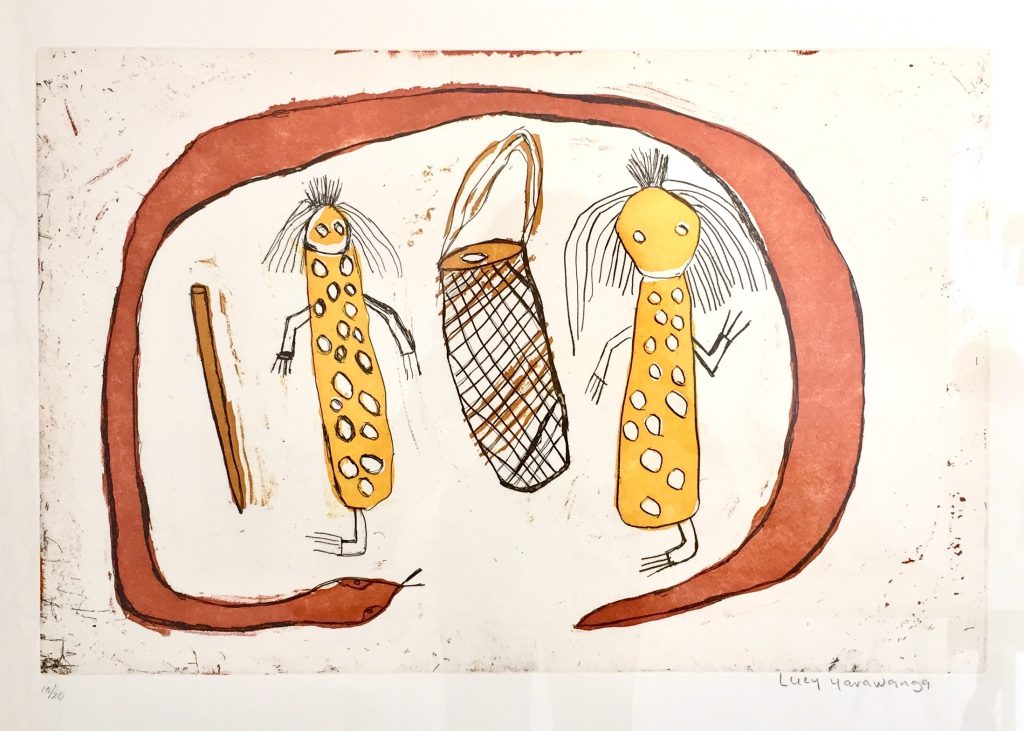
Lucy Yarawanga – ‘Bawaliba and Ngalyod (Spirit Woman and Rainbow Serpent / Esprits Femme et Serpent arc-en-ciel)’ – Etching on paper / Eau-forte sur papier – Courtesy of Babbarra Women’s Centre
Bawáliba are spirits associated with a sacred site near Djinkarr in the Maningrida region of Arnhem Land.
The Bawaliba lived a long time in peace. They were the only spirits on their country and so they were never disturbed. They loved to dance by the firelight, keeping rhythm with a stick. They had lots of hair, they were really tall and skinny, with spots on their bodies. They used to go out hunting with dilly bags and digging sticks. They used to collect a lot of bush foods, and sleep together under one bark shelter.
One day, a long time ago, the Bawaliba were out hunting and they saw a large snake – they didn’t know then but she was the Rainbow Serpent. They were really scared, they had never seen that creature before. She was really beautiful – like a normal king brown snake but with a rainbow from the sky on her back. The rainbow serpent was really hungry, and she could smell the Bawaliba from a long way away. She was out looking for food.
The Bawaliba tried to stop Ngalyod coming for them but she was just too quick. She snuck up behind the Bawaliba and before they could get away, she ate them up. When she was really full and couldn’t eat anymore Bawaliba, she changed the rest of them into stone.
Today the sacred green rock near Djinkarr, is where the Bawáliba rest during the day.
“Sometimes Bawaliba still come alive when we sleep, they come into our houses or secretly peep through the windows. They might be painted in white clay and have red cloth tied around their waist. If we get up to look, they have already disappeared.
They are really tall. They are like human beings, like us. They dance in the middle of the night, and have a lot of hair. Sometimes the carry fish traps, dilly bags and digging sticks. They are good spirits, they protect us and they recognise families. They might knock on the window to remind us they are there looking out for us.
You can hear them whisper, sometimes they talk about us and might say, ‘why are they making a house here?’ Then they say to each other, ‘This family are from here, it’s ok, they are sleeping here for the night’.”
– explains artist Lucy Yarawanga who knows this djang (dreaming or creation story) from her mother and her uncles.
SOURCES: Maningrida Arts & Culture and Bábbarra Women’s Centre.
Bawáliba
Les Bawáliba sont des esprits associés à un site sacré près de Djinkarr dans la région de Maningrida en Terre d’Arnhem et au mythe de création de ce site.
Il y a très longtemps, les esprits Bawáliba étaient les seuls esprits sur leur terre natale et vivaient tranquillement. Ils adoraient danser à la lueur du feu, en marquant le rythme avec un bâton. Ils avaient beaucoup de cheveux, ils étaient vraiment grands et maigres, avec des taches sur le corps. Ils allaient chasser avec des sacs à collecte et des bâtons à fouir. Ils avaient l’habitude de collecter beaucoup d’aliments de brousse et de dormir ensemble sous un abri d’écorce.
Un jour, il y a longtemps, les Bawáliba étaient à la chasse et ils virent un grand serpent – ils ne savaient pas alors mais c’était Ngalyod, le Serpent Arc-en-ciel. Ils avaient très peur, ils n’avaient jamais vu cette créature auparavant. Elle était vraiment belle – comme un serpent brun royal normal mais avec un arc-en-ciel sur le dos. Le Serpent Arc-en-ciel avait très faim, et elle pouvait sentir les Bawáliba de loin. Elle était à la recherche de nourriture.
Les Bawáliba tentèrent d’échapper à Ngalyod mais elle était trop rapide. Elle se faufila derrière les Bawáliba et elle les mangea. Quand elle fut rassasiée et ne pouvait plus manger de Bawáliba, elle changea en pierre ceux qui restait.
Aujourd’hui encore, le rocher vert sacré près de Djinkarr est l’endroit où les Bawáliba se reposent pendant la journée.
«Parfois, les Bawáliba prennent vie quand nous dormons, ils entrent dans nos maisons ou regardent secrètement à travers les fenêtres. Il se peut qu’ils portent des marques de peinture à l’argile blanche et un tissu rouge noué autour de leur taille. Si nous essayons de nous lever pour regarder, ils disparaissent.
Ils sont vraiment grands. Ils sont comme des êtres humains, comme nous. Ils dansent au milieu de la nuit et ont beaucoup de cheveux. Parfois, ils ont avec eux des nasses à poissons, des sacs à collecte et des bâtons à fouir. Ce sont des esprits bienveillants, ils nous protègent et ils reconnaissent les familles. Il se peut qu’ils frappent à la fenêtre pour nous rappeler qu’ils sont là, veillant sur nous.
Vous pouvez les entendre chuchoter, parfois ils parlent de nous et peuvent dire: `Pourquoi construisent-ils une maison ici? ‘. Puis ils se disent: ` Cette famille est d’ici, c’est bon, ils dorment ici pour la nuit.’ . »
– explique l’artiste Lucy Yarawanga qui connaît ce djang (rêve, ou histoire de création) de par sa mère et ses oncles.
